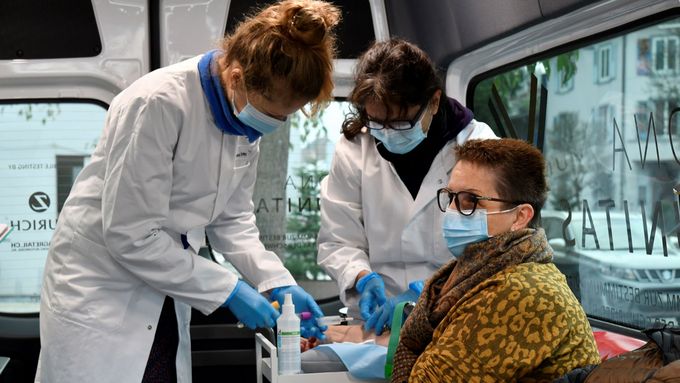Seroprevalence Has Increased to 21% in the Basel Region
26.04.2021
In the cantons of Basel-Stadt and Basel-Landschaft, antibodies against SARS-CoV-2 have been detected in approximately 21% of the adult population. Therefore, seroprevalence has markedly increased since autumn of last year. Furthermore, the COVCO-Basel study by the Swiss Tropical and Public Health Institute (Swiss TPH) is now publishing preliminary results regarding the effects that the pandemic and the measures implemented to contain it are having on the well-being and lifestyles of the population for the first time.

Swiss TPH study nurses taking blood from a study participant for the antibody test. Photo: Layla Hasler, Swiss TPH
As part of the Switzerland-wide research programme Corona Immunitas, the COVCO-Basel study is investigating the spread of SARS-CoV-2 in the population. In addition, the COVCO-Basel study is also investigating the effects of the containment measures on the well-being of population in the cantons of Basel-Stadt and Basel-Landschaft. The researchers at Swiss TPH have evaluated the effects of the pandemic for the time period between July 2020 and January 2021 and are now also able to present the latest results regarding the distribution of antibodies (seroprevalence) up to March 2021.
COVID-19 trends
Seroprevalence markedly increased during the second coronavirus wave and it has increased from 6% (in October 2020) to 13% (mid-February 2021) and then to 21% (March 2021). In the Canton of Basel-Stadt, 24% of the population currently have antibodies, whereas in the Canton of Basel-Landschaft, the proportion of the population with antibodies is 19%. The increase in the number of people who are positive for antibodies also reflects the effect of vaccinations. Until mid-January 2021, seroprevalence among those aged 75 years or over was only 8%. By mid-February 2021, that figure had increased to 53% and by mid-March, it had increased to 81% (Basel-Stadt: 86%, Basel-Landschaft: 76%).
There have been only a few detected reinfections or persistent infections during the study period. Only 4 out of 340 people who had a positive coronavirus test or a positive antibody test had another positive throat swab or still had a positive throat swab more than two months later.
Out of 243 people who reported a positive throat swab, 7% were hospitalised and 1% were admitted to the intensive care unit.
Impact of the containment measures
Over 80% of study participants rated the Swiss Federal Council’s containment measures as appropriate. Respondents rated some effects of the containment measures on the private sphere as positive – for example there was more time for family or hobbies – but in terms of the overall effects, most felt that the pandemic has had a negative impact. The participants were particularly concerned about the effects of the limits placed on travel and cultural activities. Among the participants who were employed, 80% said that they were satisfied with their work, but 6% said they were worried about losing their jobs. Among participants who were employees, 9% reported earning less than in the same month in 2019, whereas among the self-employed, this figure was 33%. In the self-employed group, the extent of lost earnings was almost 50% on average.
Impact on mental health
The COVCO-Basel study revealed that there has been an increase in the prevalence of severe and extremely severe symptoms of depression between July 2020 and January 2021. This increase has mainly affected the age group between 18 and 49 years, as well as people with a low household income. Those with a low household income were the worst affected population group: the prevalence of depression symptoms has risen from 2% to 8% in this group. Stress levels were also highest in this group and were on the increase. “People with a low income have been particularly affected by the pandemic: they are often more exposed to the virus due to their jobs and are more likely to be infected with coronavirus. At the same time, they are more adversely affected by the economic consequences of the coronavirus countermeasures and are more likely to live in cramped accommodations, which can also have a negative effect on mental health,” said Nicole Probst-Hensch, Head of the Department of Epidemiology and Public Health at Swiss TPH and Principal Investigator of the COVCO-Basel study. Increasingly, public discussion is focusing on how best to care for people with mental health conditions during the pandemic. In the COVCO-Basel study, around 10% of respondents stated that they had experienced difficulty accessing treatment, and around 10% stated that they received treatment virtually. The percentage of people who decided to avoid in-person treatment due to fears about contracting an illness increased from 4% to 12%.
Addiction problems on the increase
With regard to lifestyle, there were changes in exercise behaviour, eating behaviour and addictive behaviours. Overall, study participants were engaging in less physical activity and spent one hour a day longer sitting on average. The 18- to 49-year-old population group has been eating less healthily since the beginning of the pandemic and reports of addiction problems around eating and media consumption increased among this group, as did reports of unhealthy weight gain associated with these problems. In the 50- to 64-year-old age group, the percentage of people reporting addiction problems around alcohol increased from 5% to 10%. “The consequences of less physical activity, poorer nutrition and addiction problems could lead to chronic diseases in the long term, which in turn could become a risk factor for severe disease courses in the case of COVID-19. This pandemic has shown the close correlation between infectious diseases and chronic diseases in many respects,” said Probst-Hensch.
The COVCO-Basel study is currently ongoing. It will continue to evaluate infection trends and the impact of the vaccination programme as it progresses as well as the impact of other measures, and it will continue to investigate the long-term impact of the pandemic on the economy, society and the health and well-being of the population.
About the COVCO-Basel study
The COVCO-Basel study is being conducted by Swiss TPH and is co-financed by the cantons of Basel-Stadt and Basel-Landschaft. One part of the study consists of a seroprevalence cohort, which provides an insight into how many people have antibodies against SARS-CoV-2 – i.e. how many people have already been infected with SARS-CoV-2 or have been vaccinated. The other part of the study is a digital cohort, which provides an insight into the effects of the pandemic on personal circumstances and the well-being of the population. Over 10,000 people have taken part in the study to date. The COVCO-Basel study was designed from the outset as a long-term study whose aim was to track changes in people’s economic and personal circumstances and changes in the social environment and living conditions in the Basel area during the pandemic. The COVCO-Basel study is part of the Swiss-wide research programme Corona Immunitas, which is being conducted by the Swiss School of Public Health (SSPH+). Corona Immunitas is a scientific programme designed to measure the extent of SARS-CoV-2 immunity.
Contact

Nicole Probst-Hensch
Professor, PhD (Pharmacy and Epidemiology), MPH
Head of Department, Group Leader, Head of Unit
+41612848378
nicole.probst@swisstph.ch
Stay connected
Subscribe to our newsletter and get all the latest research news, project updates, course and event listings from Swiss TPH.